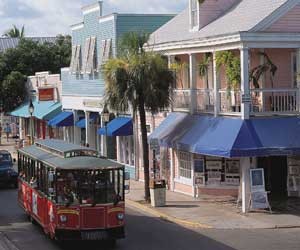Small-town Florida is like a time-out for visitors looking to escape the bustle of the city, not to mention the compressed itinerary of a meeting or convention. In fact, a half- or full-day trip to one of these communities might be the perfect way to decompress before, during or after an event.
"We encourage groups to make time for this experience," says D.T. Minich, executive director of Visit St. Petersburg/Clearwater. "These smaller areas are really unique, and we work closely with planners to show them that they can tack on a day or two without it being that expensive."
No City Limits
If time is an issue, these small-town hideaways are often within minutes of big-city limits. Take Tarpon Springs, which appears to have been plucked from the shores of the Aegean Sea but is actually a quick drive north of St. Petersburg and Clearwater Beach. Built by Greek immigrants and the sponge-diving industry in the late 1800s, this harbor town still operates a commercial waterfront where the sponge boats haul their catches in every night and where tour boats depart by day.
Meanwhile, the expansive county of Palm Beach may be known for seaside havens like Boca Raton, but it also borders the southern shores of Lake Okeechobee—the second-largest freshwater lake in the continental U.S. Here, you’ll find the town of Pahokee, home to Old Florida cracker-style houses and tiny churches, and it is also a great launch point for boating and fishing excursions.
Across the state, you’d never guess that a place like Everglades City would be a quick drive from the Gulfside enclaves of Naples and Marco Island. Although calling it a "city" is a bit of a stretch, since the year-round population is about 500. Yet that figure swells during the winter months, the best time to trek through Everglades cypress swamps and mangrove forests, and when visitors packing fishing rods, boats and hiking boots descend to soak up a bit of frontier Florida.
North of Naples near Fort Myers, the Gulfside retreat of Pine Island is the "road less traveled" in these parts. Surrounded by mangroves and three aquatic preserves, and zoned mostly for agriculture, Pine Island escaped mass development and instead has cultivated a fishing village/artistic refuge vibe. Even the telephone poles sport original paintings by local artists.
"Artists seem to congregate here, and there’s a lovely string of art galleries and jewelry artisan shops on Pine Island," notes Pamela Johnson, director of sales for the Beaches of Fort Myers & Sanibel. "For folks who are visiting our area and looking for something off the beaten path, Pine Island is a hidden gem."
Hidden gems are all over the Gulf Coast heading northward, from the waterfront town of Punta Gorda, set on the shores of Charlotte Harbor and with a downtown pulled straight out of a history book, up to Citrus County, where historic areas—Inverness, Floral City, Homosassa and Crystal River—are home to such prized heritage sites as the 1884 Floral City Methodist Church and the Old Railroad Depot (circa 1900), recalling the region’s boom days as a center for phosphate mining.
In Central Florida, picturesque hamlets like Lake Wales and Mount Dora are filled with unexpected treasures, including antique districts and historic buildings. Keep heading northwest through a landscape of crystal springs and horse farms, and you’ll reach the lovely city of Ocala, whose historic downtown area is filled with Victorian, Tudor and Colonial Revival homes.
Southern Comforts
Before early engineers figured out how to drain the swamps covering interior Central Florida and South Florida in the 1700s and 1800s, the state’s colonial and antebellum population was primarily confined to the upper third of the peninsula, and vestiges of this time period are everywhere, from Pensacola to Jacksonville and points in between, including the capital city of Tallahassee—home of 19th century government buildings and a huge concentration of original plantations.
But coastal North Florida has its own small-town delights, as groups will discover heading southeast from Panama City Beach along Route 98, toward the "forgotten" coastal town of Apalachicola, an outpost of the Old South with a strong maritime culture and an eclectic collection of local shops and galleries along with meticulously restored bed-and-breakfast properties.
"It’s a beautiful drive right along the Gulf of Mexico," says Dana Lent, communications manager for the Panama City Beach CVB.
On the Atlantic side, there might as well be a time machine at the entrance to Fernandina Beach, whose Victorian and Beaux Arts buildings immediately transport the visitor back to the 1800s.
Key to History
At roughly four miles by two, you can’t get much more "small town" than Key West, but despite its size, this island that bookends the Florida Keys chain is packed with history, particularly in its Old Town district. The area can be explored entirely on foot and includes the Audubon House & Tropical Gardens educational institution; the Hemingway House, where the Nobel prize-winning author penned some of his classics; and the Harry S. Truman Little White House, built in 1890 but used by the 33rd president as a vacation retreat.
Cuban, Bahamian and U.S. military history all converge in Key West, and the island fills frequently thanks to a year-round calendar of festivals, yet somehow the "Southernmost City" retains its small-town feel. It could be the laid-back atmosphere. It could be the narrow streets that force people into close proximity and friendly conversation. But it’s probably the nightly Sunset Celebration in Mallory Square, when crowds bid adieu to the sun as it sinks into the Gulf of Mexico amid a festive atmosphere of jugglers, tightrope walkers, musicians and margaritas.






